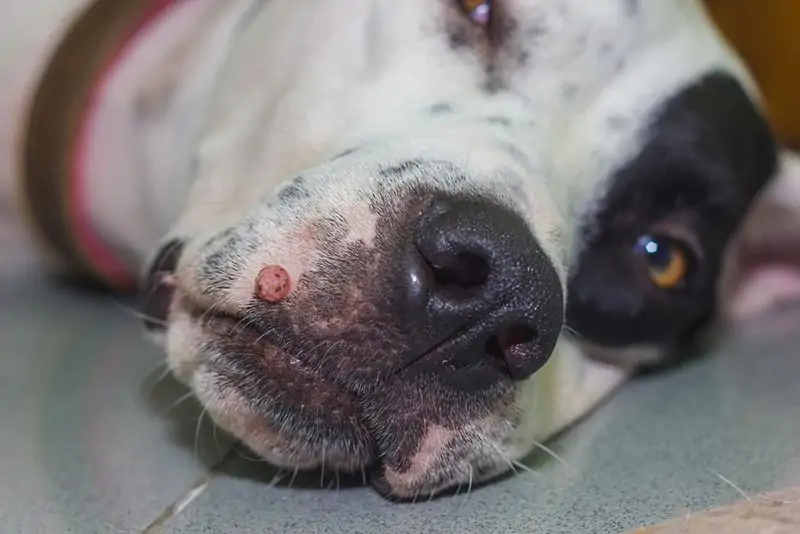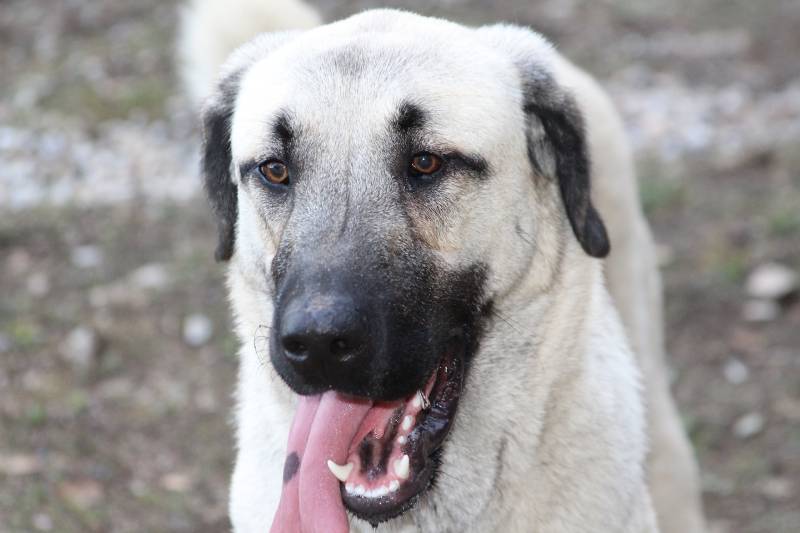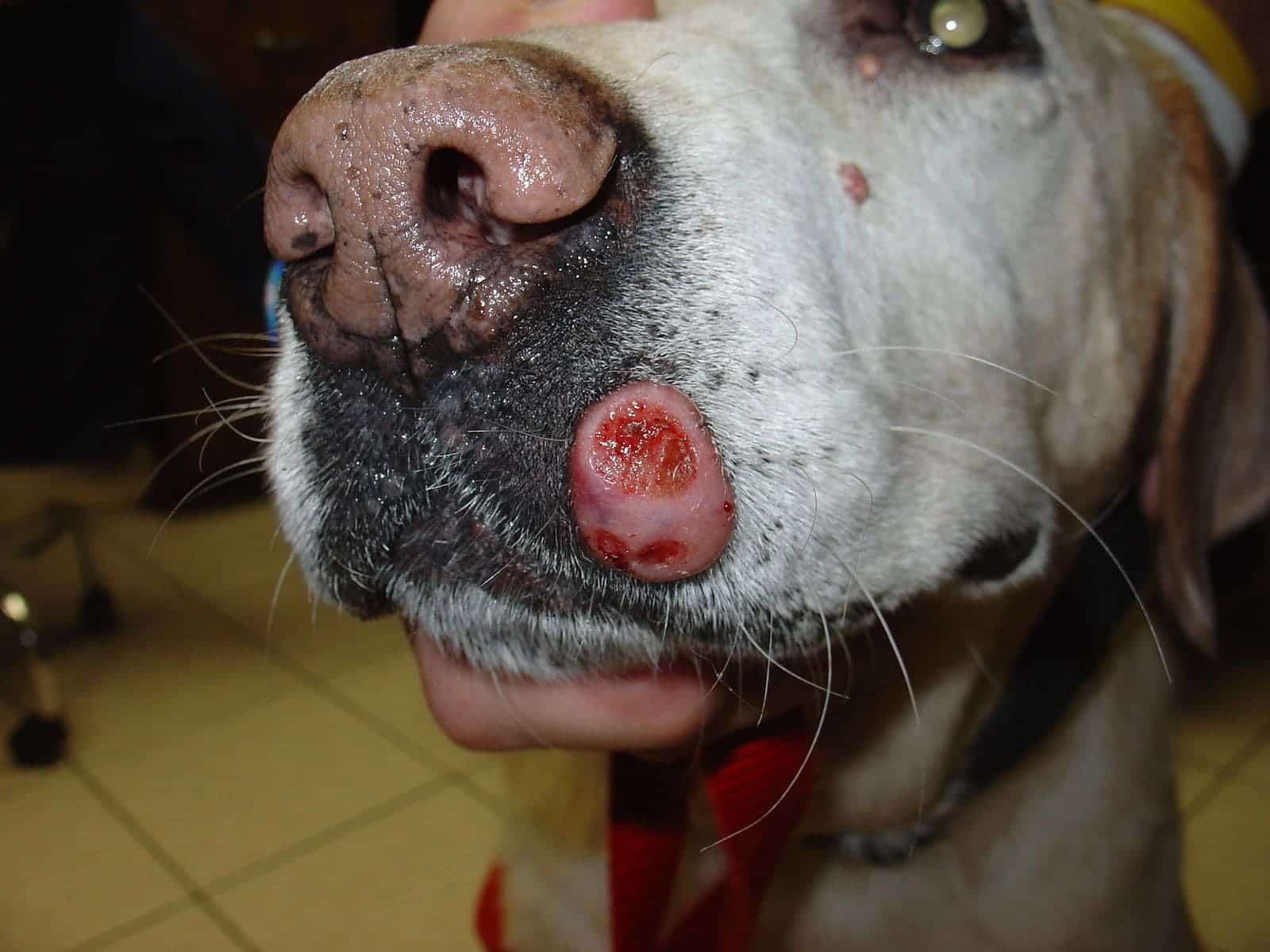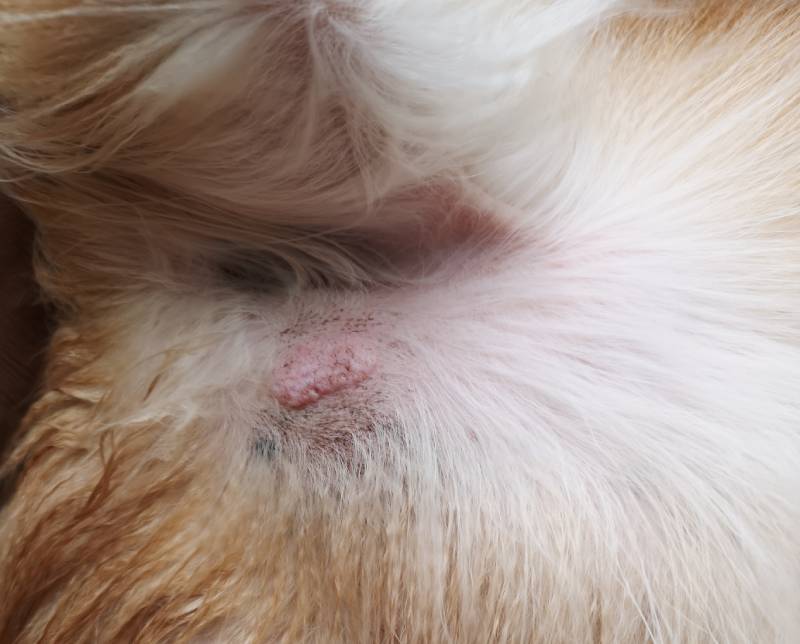Click to Skip Ahead
At some point in your life, you’ve probably looked down at your skin and noticed the appearance of a mole. Moles are fairly common in humans, and though they are mostly harmless, they can occasionally be a sign of cancer. If you’re a dog parent, you might have found a spot on your pet that resembles a mole. But do dogs get moles?
They do. Dogs developing moles are less common than humans, but it can occur. And as with people, most of the time, these moles are benign. However, there may be cases where a dog has a mole that isn’t harmless or where what you’re looking at isn’t a mole. Here’s what you need to know about moles on dogs.
What Are Moles?
First off, you should understand exactly what a mole is. A mole, or melanocytic nevus, on canines is typically a well defined, slightly raised lesion that is brown in color. Occasionally, the mole can displace hair follicles, leaving the area where the mole is hairless. The skin around the mole shouldn’t be red and inflamed and once you’ve discovered it, the mole shouldn’t change too much in appearance.
In most instances, moles will be benign, but rarely, they will not be. Any sudden changes in size, color or texture can be a cause for concern. There are also a few other things that can first look like moles on a dog but aren’t that could be less benign.


If It Isn’t a Mole, What Is It?
Say you’ve found a spot on your pup that looks like a mole; how do you know for sure that it is? Other things can look like moles at first glance—some harmless, some not. In most cases, you’ll need to check with your pet’s vet to find out if it is indeed a mole or something else. However, here are some of the more common things that can also look like moles on dogs.
1. Ticks
If you think you see a mole on your dog, you may want to check closely to make sure it isn’t a tick. Sometimes, if you are just having a cursory look at your pup, a tick can look very much like a mole. It makes sense, as a tick would look like a darker, slightly raised spot on your pup. However, if you look closer, you should be able to see the legs if it’s a tick. Also, be sure to take a good look if you think you’ve located a tick on your canine pal; if it ends up being a mole, your dog is not going to be happy about you trying to remove it!
2. Skin Tags
Have an older dog? Then, you’re likely familiar with skin tags. Skin tags grow from the skin and can begin to dangle if they get large enough. Though any dog can have them, they’re more common in senior dogs. They’ll show up around the face, ankles, and elbows, and when they first start growing, they can sometimes resemble a mole. Skin tags are benign growths that don’t hurt your dog but can sometimes need to be removed if your dog keeps catching them.

3. Sebaceous Cysts
Sebaceous cysts can also look similar to moles at first, as they are raised bumps that sometimes have a bluish tint, making them appear darker than the skin around them. These cysts come from the sebaceous gland, which is responsible for secreting sebum, or the oil that helps keep your pup’s skin and coat healthy. These cysts are another benign occurrence, though they can rupture on occasion.
4. Hemangiomas
Hemangiomas might also look like a mole at first glance. Hemangiomas, or vascular tumors, are circular lumps that appear reddish-black in color. They, too, are benign and can be found on a dog’s legs. This doesn’t mean hemangiomas can’t cause issues, but they aren’t cancerous.

5. Basal Cell Tumors
Then, there are basal cell tumors. Don’t let the name frighten you; these are almost always benign. This isn’t always the case (so you definitely want to have your vet check things out), but most often, basal cell tumors are benign. These tumors usually show up on the head, neck, and legs and can be dark in color. They are also raised and firm to the touch.
6. Mast Cell Tumors
Mast cell tumors can have a variety of appearances and might look like moles when they first show up, but they’ll usually quickly stop looking like this once they start to grow. Unlike the above skin issues, mast cell tumors are cancerous. They can spread quickly and should be treated immediately.

7. Melanomas
Like humans, dogs can also get melanomas. Unlike in people, benign melanomas (also called melanocytomas) are diagnosed in dogs most frequently. However, this isn’t always the case. Aggressive malignant melanomas can occur, most commonly around the lips, mouth and nails beds. Melanomas appear as small black or brown masses and should be checked by a vet to ensure they are, indeed, benign.
What Should I Do if I Think My Dog Has a Mole?
If you find a spot on your dog that you believe is a mole, you should have your vet check out. Any time you find any sort of skin growth on your pet that is brand new, it should be looked at by a veterinarian. As you saw, many things can look like moles, but some may not be moles, and some aren’t benign.
When your vet examines the potential mole, they might decide to take a sample so they can test it to be sure it’s benign. This sample will most likely be done in the form of a fine needle aspirate, which simply means they’ll stick a needle into the potential mole and draw out cells that can be sent off for analysis. Once the analysis is complete, your vet will better understand what exactly the skin growth is and whether it needs to be treated.
Even if your vet says it’s merely a mole, keeping an eye on the area is always a good idea. If you see that the mole has changed in size, color, or texture, there could be something less benign going on. And if you notice that the mole is inflamed or bleeding, you absolutely want to have it checked out.

Conclusion
Dogs can get moles, and in most cases, it’s no cause for concern. However, your dog may have a skin growth that looks like a mole but actually isn’t. While in many cases, skin growths that resemble moles are also benign, this isn’t the case for all of them. So, if you find a mole or any other sort of skin growth on your pup, you should have your vet examine it so they can ensure that it is harmless.
Featured Image Credit: AT Bea, Shutterstock











